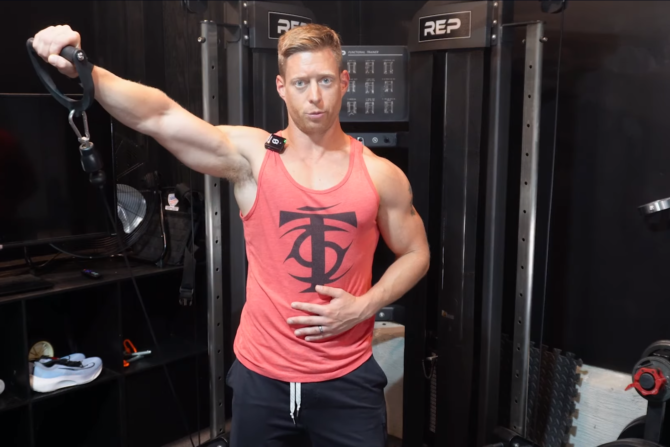
5 Lateral Raise Variations That Actually Work
How to Build Wide Delts
The medial delts are hard to hit, even with standard lateral raises. But these variations add shoulder width in record time. Check ‚em out.
Building capped shoulders is equal parts effort and intelligent programming. Pressing lifts trigger plenty of anterior head growth, and pulling smokes the posterior head. But this leaves a massive programming gap: the hard-to-grow medial head.
Building the medial head adds width to your shoulders and enhances the V-tapered appearance for men. It also helps create an hourglass shape for women: wider shoulders create the illusion of a narrower waist.
Classic Dumbbell Lateral Raises? Meh.
The role of the shoulder’s medial head is abduction – bringing the arm away from the body. The dumbbell lateral raise is a workout mainstay, but it leaves gaps. Luckily, there are better options.
Lateral raises don’t have the ideal strength curve for optimal development. Take a moment and do a lateral raise. There’s no tension on the bottom, and the lever arm increases as you get to the top when the muscle is in a fully-shortened position. So, the load feels heaviest where you’re weakest. This leads many lifters to “cheat” and add excess body English to properly stimulate the delts (and ego).
Here are five exercises that fix those problems:
1. Single-Arm, Behind-the-Back Cable Lateral Raise
Cables work around the limitations of dumbbell lateral raises. They provide constant tension through the full range of motion and load the medial delt at the bottom of the range where tension is non-existent with dumbbells. When facing away from the cable machine, you can hit the medial delt through a complete range of motion with constant tension while staying in the scapular plane.
Directions
- Adjust the pulley to the lowest setting and attach a single handle to the cable.
- Stand with feet shoulder-width apart, facing away from the cable machine.
- Grasp the handle with one hand behind your back using a pronated grip.
- Maintain a slight bend in your elbow and keep your torso upright with your core engaged.
- Initiate the movement by lifting your arm forward/out in the scapular plane.
- Slowly lower your arm back down to the starting position, controlling the weight throughout the movement.
- Complete the desired number of reps on one side before switching to the other.
2. Dumbbell Y-Raise
The exercise emphasizes the medial delts while creating high tension in the shortened, contracted position at the top. Using a bench to create an incline creates a more stable environment, reducing cheating. For added difficulty, adjust the bench angle. Flattening the bench increases the resistance arm at the top position.
Directions
- Set up a bench with a 75-degree incline and position yourself with your chest on the backrest.
- Raise the dumbbells and create a Y-shape with your arms.
- On the eccentric/negative, stay just shy of the bottom position to maintain optimal tension.
3. Cable Y-Raise
Like the last one, this Y-raise creates high tension at the top in the shortened and contracted position. Compared to the dumbbell version, though, there’s no bench. So, you don’t have the same external support. However, the cables create constant tension through the movement. Adjust the difficulty by stepping back, stepping forward, or changing the load.
Directions
- On a functional trainer, set the arms/cables at their lowest setting.
- Use a cross-cable set-up. This helps align the line of pull with your muscle fibers.
- Keep your arms relatively straight and form a “Y” at the top.
- Pause and hold peak contraction before lowering slowly under control.
- To increase difficulty, step away from the machine.
4. Cable Wrist-Height Lateral Raise
Setting the cable up at wrist height carries the same benefits as cable lateral raises but biases more of the movement’s end range. So, you can go a bit heavier than a low-cable lateral raise, which biases the movement in the full, lengthened position.
Directions
- Adjust the cable machine to hip height and attach a single handle.
- Stand away from the machine with your feet shoulder-width apart.
- Maintain a slight bend in your elbow and a slight forward bend with your torso, but keep your core engaged.
- Lift your arms out to the side, keeping them straight and raising them to shoulder level or slightly higher.
- Lower your arms back down with control, keeping tension on the muscle.
5. Dumbbell Lean-Away Lateral Raise
These work incredibly well as the first exercise in your isolation work or as the first exercise in a mechanical drop set 11. This exercise puts the medial delt under tension for a greater range of motion than the standard version. You may find that you can load it up heavier, which helps tap into high-threshold motor units that typically aren’t stimulated. Because of the body position, you can cheat a bit on the concentric, but control the eccentric action, creating additional overload.
Directions
- Stand with your feet shoulder-width apart, holding a dumbbell in one hand at your side.
- Keeping your feet planted, hold on to a stable machine or a squat rack and lean slightly away from it.
- Maintain a slight bend in the elbow of the working arm and keep your core engaged.
- Begin the movement by raising the dumbbell out to the side, keeping your arm straight.
- Lift it to shoulder level or slightly higher, feeling the lateral deltoid contract.
- Lower it back down in a controlled manner, maintaining the lean.
- Complete all your reps on one side before switching to the other.

